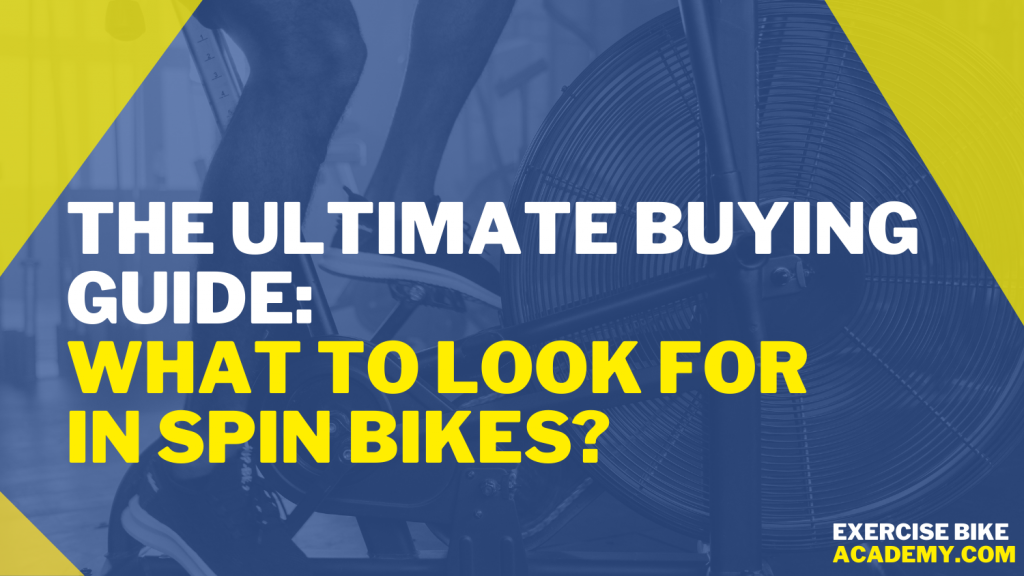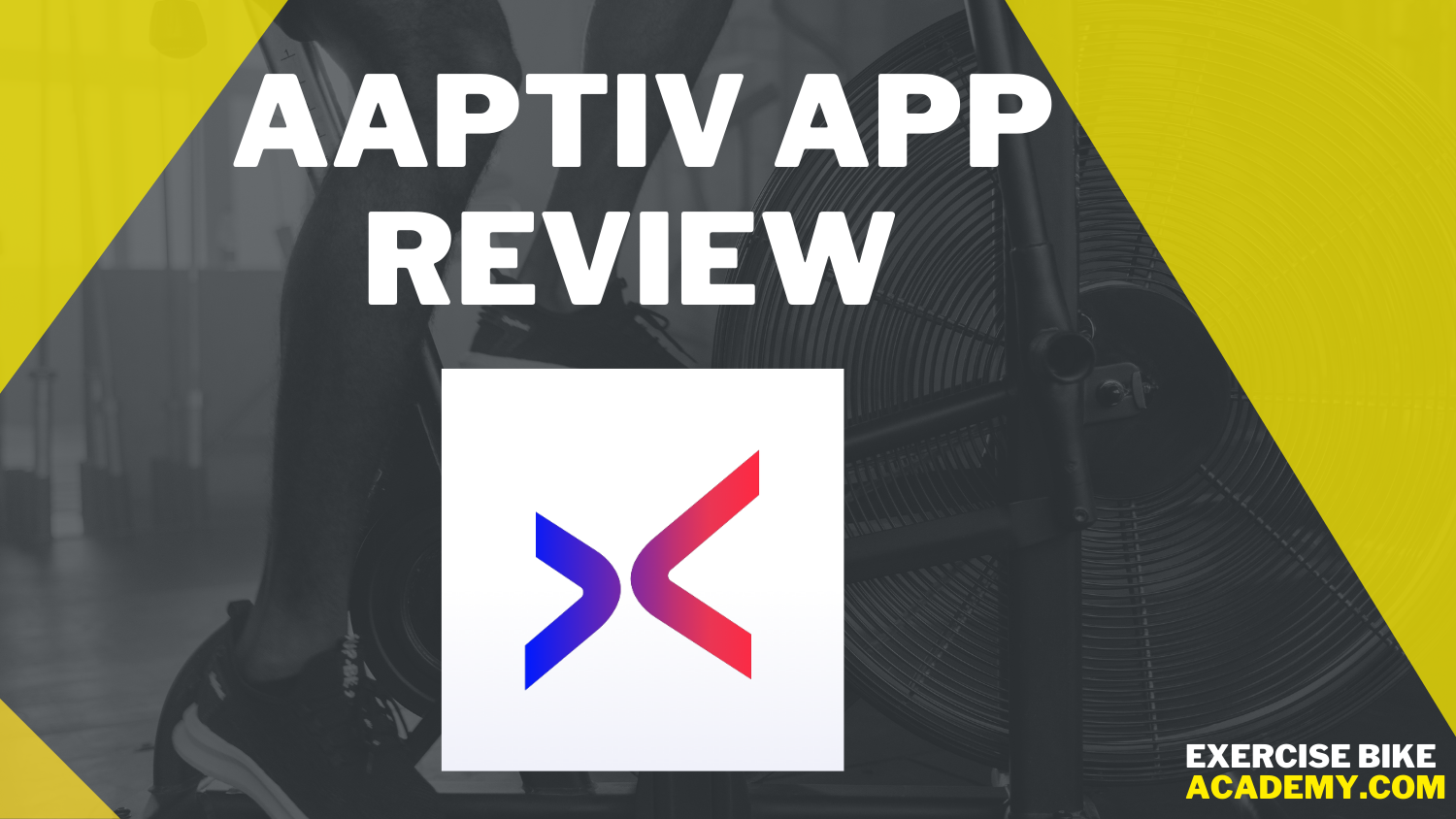One of the many reasons we love cycling is that it enables us to get out of the house and explore the great indoors. With two wheels and a set of pedals (and maybe a few other accessories), we can get to places while improving our overall fitness level.
However, the unfortunate truth is that even if we are the most dedicated riders, there’s just nothing we can do when winter arrives at our doorstep or when the weather outside is just plain awful.
Therefore, owning a spin bike is the next best option as it saves us from the usual constraints caused by the weather. Furthermore, it allows us to work on our fitness at any time in the comfort of our homes.
This article breaks down eight essential features for anyone investigating what to look for in spin bikes. So, if you’re looking to invest in a spin bike, you’ve come to the right place!

Contents
Why Use Spin Bikes?
Some exercises can be intimidating when done the first time, and spinning is no exception. But even if you’ve never used a spin bike a day in your life, you can rest assured that getting that great figure at home is doable. With a spin bike, you can take classes that range from beginner to expert, each of which helps burn calories and tone your muscles.
A 60-minute session helps build up lean muscle definition for your core and legs. And when you increase the resistance from time to time, you’ll get extra power to get toned as you desire.
When you’re cycling outdoors, it’s just you and nature, which is a good thing when you want to lessen the effects of physical and mental stress. But let’s be honest, it can be tough to ride your bike alone and finish a particularly challenging ride.
On the contrary, riding a spin bike spices things up and provides motivation. With a fitness instructor cheering you on, it’s not hard to keep going and stay on top of your workouts.
As well as helping you tone up, spin bikes help you avoid heat, dust, rain, and pollution. It also keeps you from road accidents and many other road cycling risks. Hence, from the perspective of training, spinning is a safe exercise that benefits your health.
How to Choose the Best Spin Bike
Monitoring Functions and Display
Most high-end spin bikes have pulse sensor handlebars that monitor your heart rate and display it on the screen. The accuracy of these sensors enables you to keep track of your health status while riding. These bikes also have monitoring systems connected to their LCD Display that allows you to view the length of time you exercised, the distance you traveled, the speed of your cycling, and the calories you have burned during your workout session.

Contrarily, basic spin bikes come with a basic console display and offer less information. For example, there is no real-time information on your heart rate.
Type of Resistance
There are two common ways spin bikes provide resistance while you pedal:
Frictional
This is the most common form of resistance, which uses friction pads to increase or decrease resistance. If you choose a spin bike with frictional resistance, expect a lower price point. This is because spin bikes with the said resistance are typically cheaper to manufacture.
Besides being cost-effective, this type of resistance stays the same regardless of how fast you’re pedalling, providing a consistent workout.
There is a downside, though. Bikes with frictional resistance tend to produce noise due to the contact between the flywheel and the friction pad. Also, when these bikes aren’t properly lubricated, you may find them squeaking when in use.
Magnetic
Instead of using friction, this one uses two magnets to generate resistance. Some bikes with this type of resistance feature a knob, while others use magnets to be moved via the onboard console.
The resistance is created smoothly because the magnets don’t touch the flywheel. The main advantages are that the bike operates quietly and requires less maintenance. You don’t get the squeaking sound associated with a frictional spin bike, and you don’t need to replace pads or re-apply lubricants.
One disadvantage is that magnetic resistance bikes are more expensive than frictional bikes because of the improved consistency, reliability, and quiet, smooth operation.
Type of Drive System
Like the type of resistance, the drive system defines how a bike operates. There are two main types: chain drive systems and belt drive systems.
Chain Drive
This type of drive system is usually found on older spin bikes and outdoor bikes. Many agree that the outdoor feeling is one of the many attributes that draw riders to the chain drive system. After all, who doesn’t like the feeling of riding an actual bicycle without actually riding in one?
Another benefit is that the chain drive system is typically used with spin bikes that are cheaper than those with belt drive systems. This makes it suitable for riders looking to get one of these machines on a limited budget.
Chain drives also deliver maximum power without the bike stretching or jerking. So, even if you ride the bike while standing up or set the highest resistance setting, the bike remains stable and consistent.
However, the chain drive system is louder than its belt drive counterpart, and this is most definitely the most significant issue that comes with it.
Belt Drive
Belt drive mechanisms are the new thing in exercise bikes. The first example is the Poly-V belt drive, which provides a smooth ride. In terms of feel, it’s not as natural as the chain drive system; however, it’s as smooth. In terms of performance, it can last for much longer without needing to be fixed or lubricated. This also means that the Poly-V belt drive is significantly easier to maintain than its counterpart.
Then there’s the toothed belt drive system, which shares many of the Poly-V belt drive’s advantages. It can support the most intense workouts while providing a nearly silent workout experience. If you want to push your body to the limits without disturbing the entire household, this is most definitely something to keep in mind.
Weight of the Flywheel
The elevated wheel at the centre of a spin bike is called a flywheel. When you start pedalling, the flywheel starts spinning. When considering what to look for in spin bikes, the weight of the flywheel should be included.
Heavy Flywheel
A heavy flywheel generates more energy and creates a better resistance. But because you need to pedal harder to get the flywheel moving, this puts more pressure on your knees. Bikes with a heavy flywheel also spin relatively slower than bikes with a light flywheel.
Light Flywheel
On a positive note, a light flywheel spins faster and is not hard on your knees.
For a thorough comparison of a light flywheel and a heavy flywheel, check out this post:
Pedals

Where your feet will go is another important consideration. Spin bikes can either have single-sided toe cage pedals or dual-sided SPD pedals with toe cages. Keep on reading to find out their fundamental differences.
Single-sided toe cage pedals
As you might expect, these are one-sided pedals and are commonly called flat pedals. With these pedals, you can reduce the risk of injury as your body naturally places your foot in a comfortable and healthy position. You can also adjust your foot position easily.
Dual-sided SPD pedals
On the other hand, the dual-sided SPD pedals provide a higher degree of control, allowing you to navigate trails more precisely during your ride. These are ideal if you want a more intense workout or you have an indoor bike that simulates mountain riding.
But remember this: Not all spin bikes offer SPD compatibility, so you may have to buy separate pedals.
See also: What Cleats Do I Need For Spin Bikes?
Adjustability
This feature in your spin bike is vital if multiple bike users are in the same household. You should be able to adjust the height of the seat and handlebars to suit different riders and ensure a comfortable cycling experience at home.
Keep in mind that spin bikes with horizontal adjustment only, either in the seat or handlebars, cannot serve all types of riders. If you are on the taller side, it’s ideal for getting a spin bike with a seat and handlebars that adjust both vertically and horizontally.
Connectivity
The amount of smart technology in a spin bike is another key consideration.
High-end spin bikes come with smart systems, offering the ability to connect to third-party apps, automatically stimulate different terrains, and all other sorts of cool features. This is a vital consideration if you’re looking to take your indoor cycling to a whole new level. The only downside is that these bikes can be quite expensive.
Accessories
Last but certainly, not least is the accessories that come with the bike.
Most budget bikes feature a bottle holder, which keeps riders hydrated during longer rides. On the other hand, more expensive bikes feature dual bottle holders, so you don’t have to stop your workout and refill the water bottle. You can also use these holders for your towel and other gym equipment.
Other convenience features to consider before buying a spin bike are a tablet holder and transport wheels. If you follow specific workout programs while you pedal, it helps to have your tablet conveniently placed in front of you. Also, if you have limited home space, it helps to use the transport wheels and quickly move the bike to a corner after use.
What to Look For in Spin Bikes: Final Words
That wraps up our list of important spin bike features.
If you want to ensure your safety and comfort while keeping fit, choose a fully-adjustable spin bike with extra features, such as transport wheels, bottle holder, and tablet holder.
If you’re a beginner in spinning, start with flat pedals as they have a lower risk of injury and are more confidence-inspiring than dual-sided SPD pedals.
And if you have a limited budget, choose a bike with frictional resistance, a heavy flywheel, and a basic console display.
Now that you know the features to look for in spin bikes, select the best one for your needs.
Happy cycling!






